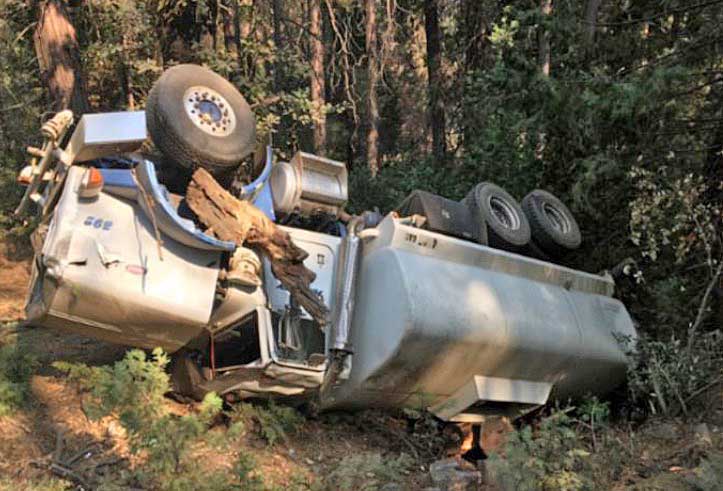Two water tenders rolled over while working on wildfires in California and Oregon earlier this month. According to the very brief Rapid Lesson Sharing reports filed with the Wildland Fire Lessons Learned Center, there were no serious injuries. No assumptions were made about the cause of either accident, and road conditions were not mentioned as being an issue.
The first occurred on the Ferguson Fire in California August 10, 2018. The brief report can be downloaded here.

The other rollover occurred two days later on August 12 on the Miles Fire in Oregon. (brief report)

This is one of 51 articles we have written on Wildfire Today about rollovers of vehicles on wildland fires. They occur far too often.
It is not always possible to point to a single cause of many of these sometimes fatal accidents. But challenges facing drivers of emergency vehicles on wildland fires include visibility due to smoke or dust, long hours leading to fatigue, low standard or inadequately maintained roads, distractions, skills needed to drive a large heavy vehicle, top-heavy vehicles, weights exceeding manufacturer’s GVW rating, and shifting of weight caused by partial loads of water in the tank.
Of the 440 fatalities on wildland fires from 1990 through 2014, 22 percent were related to vehicle accidents.
The Rapid Lesson Sharing report for the accident on the Miles Fire reached this conclusion:
Statistics show that the biggest risk to firefighters today is the mundane task of driving to and from the worksite. Often, the function of driving is accompanied by fatigue from the day’s events and thoughts of what is yet to come.
Water Tender operators are asked to drive large, heavy vehicles in variable conditions repeatedly for multiple operational shifts. Just like line firefighters, these professional drivers must fight fatigue and complacency from the beginning of an assignment to its end.

Baffles in a tank keep liquids from sloshing front to back not side to side. They only slow the movement down. Not stop it. Speed can be a factor in accidents if a turn is being made at too high a speed. Slowing down before a turn being made is always the safest bet. I’m not saying this was the cause of these two accidents. I know from experience that driving a tank with liquid means that you should drive to the conditions of the road. It actually states something to that affect in the driver’s DOT manual.
They already have baffles if they are compliant.
It may be better out there but around here tenders are often homemade out of a vehicle designed for another purpose. Then you take a driver that drives a honda civic daily, throw them behind the wheel of a vehicle with 12 tons of water in it, and have them driving in high stress environments and bad things are bound to happen. One nearby department doesnt send tenders emergent. They must follow normal traffic laws. I was driving one following a type 6 to a grass fire. I drove normal traffic and caught alot of lights and still arrived just a few minutes behind. The BC can request them to upgrade to emergent.
I believe all water tender tanks have to be baffled, at least two lateral baffles with opposing access holes. Some even have the floating baffles which work very well. If fatigue is determined to be a factor then maybe it’s time to reconsider the 2:1 work to rest ratio. Working 14 to 16 hours a day with 8 to 10 hours off is very exhausting for all wildland firefighters. When you take into consideration your meals, a shower and pre-shift briefing you may only be getting 6 to 8 hours sleep and sometimes this is not quality sleep. Maybe going back to the 12 hours on and 12 hours off like the early to mid 90’s would make sense? The quality of sleep doesn’t change but it does provide more time for rest.
Seems like this happens alot and more so as wildland fire increases. Is there a design flaw in these vehicles? Can the tanks for water be sectioned so water is not sloshing about in a 3/4 full tank and causing an imbalance on an already large vehicle trying to navigate rough and uneven roads. Compartmentalized tanks sectioned off into 3 – 4 sections, might keep these vehicles on the roads.
They are partitioned